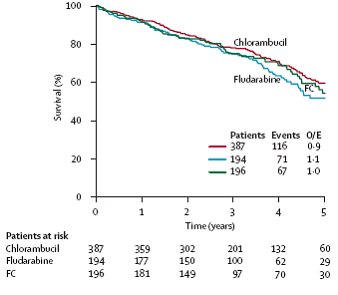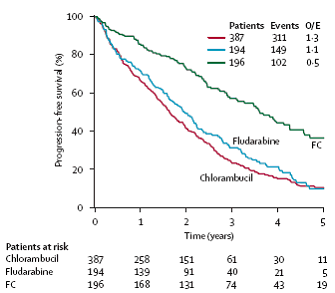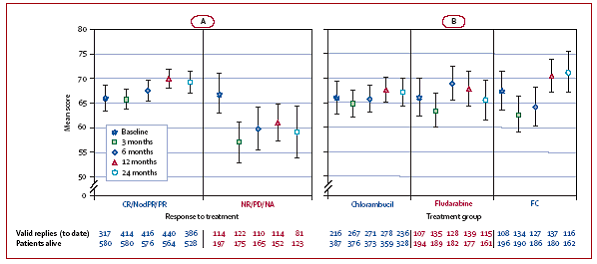Fludarabine phosphate, tablet 10 mg , injection 50 mg , Fludara, March 2008
Public summary document for Fludarabine phosphate, tablet 10 mg , injection 50 mg , Fludara, March 2008
Page last updated: 04 July 2008
Public Summary Documents
Product: Fludarabine phosphate, tablet 10 mg , injection 50 mg , Fludara
Sponsor: Bayer Australia Ltd
Date of PBAC Consideration: March 2008
1. Purpose of Application
The submission sought a section 85 Authority Required listing for the treatment of B-cell chronic lymphocytic leukaemia (CLL).
2. Background
At the March 1998 meeting, the PBAC rejected an application to list fludarabine powder
for injection 50 mg on the basis that the high incremental cost-effectiveness ratio
was unacceptable in view of the lack of details on the quality of life (QoL) of the
patient.
At the September 2002 meeting, the PBAC rejected a submission for fludarabine 10 mg
tablets for an authority required listing for second-line treatment in patients with
CLL. The application was rejected in view of uncertain clinical benefit and an uncertain,
but high, cost-effectiveness ratio. The PBAC also considered that any restriction
to list would need to specify pathology requirements for diagnosis of CLL to minimise
use outside the proposed restriction in other conditions such as non-Hodgkin’s lymphoma.
At the March 2004 meeting, the PBAC rejected an application for fludarabine 10 mg
tablets for second-line treatment of CLL because of uncertainty in the nature and
extent of clinical benefit in the proposed population and the resulting uncertain
cost-effectiveness.
3. Registration Status
Fludarabine was TGA registered on 20 June 1995 for use as second-line therapy in patients with chronic lymphocytic leukaemia (CLL). Fludarabine was TGA registered on 6 April 2004 for the treatment of B-cell chronic lymphocytic leukaemia.
4. Listing Requested and PBAC’s View
Authority required
Treatment of B-cell chronic lymphocytic leukaemia in combination with an alkylating
agent where the patient has advanced disease (Binet stage B or C) or evidence of progressive
disease.
Stage A progressive disease is defined by at least one of the following: persistent
rise in lymphocyte count with doubling time less than 12 months; a downward trend
in haemoglobin or platelets, or both; more than 50% increase in the size of liver,
spleen, or lymph nodes, or appearance of these signs if not previously present; constitutional
symptoms attributable to disease.
The diagnosis of CLL must have been established based on:
- a lymphocytosis, with ≥ 5 x 109 lymphocytes/L in the peripheral blood; and
- a clonal population of B-cells (CD5/CD19) documented by flow cytometry.
The PBAC had no objections to the requested wording of the restriction.
5. Clinical Place for the Proposed Therapy
Chronic lymphocytic leukaemia (CLL) is a slow growing cancer that affects the blood
and bone marrow. The bone marrow produces too many immature lymphocytes, which crowd
the marrow, interfering with normal blood cell production and the body’s ability to
fight infection. Over time, a shortage of red cells and platelets can also occur,
causing anaemia, bleeding and/or bruising.
Fludarabine would provide a treatment alternative for patients with advanced or progressive
CLL.
6. Comparator
The submission nominated chlorambucil as the main comparator. The PBAC accepted this as appropriate.
7. Clinical Trials
The re-submission presented one direct randomised comparative trial comparing fludarabine
and cyclophosphamide (FC), chlorambucil monotherapy, and fludarabine monotherapy,
with a median duration of follow-up of 41 months (trial CLL4); two supplementary randomised
comparative trials comparing FC and fludarabine monotherapy, with a median duration
of follow-up of 22 and 24 months, respectively (Eichhorst et al, 2006; Flinn et al,
2007); and one meta-analysis of the aforementioned direct randomised comparative trials
comparing FC and fludarabine monotherapy in untreated patients with CLL.
Details of the published studies are presented are in the table below.
Trials and associated reports presented in the re-submission
|
Trial ID |
Publication title |
Publication citation |
|---|---|---|
|
Direct randomised trial |
||
|
Catovsky 2007 (CLL4) |
Catovsky D, Richards S, Matutes E, Oscier D, Dyer MJS, Bezares RF et al |
Lancet 2007; 370:230-9 |
|
Supplementary randomised trials |
||
|
Eichhorst 2006 |
Eichhorst BF, Busch R, Hopfinger G, Pasold R, Hensel M, Steinbrecher C et al |
Blood 2006; 107:885-91 |
|
Eichhorst BF, Busch R, Obwandner T, Kuhn-Hallek I, Herscbach P, Hallek M |
Journal of Clinical Oncology 2007; 25(13):1722-31 |
|
|
Eichhorst BF, Busch R, Schweighofer C, Wendtner CM, Emmerich B, Hallek M and the German
CLL Study Group (GCLLSG) |
British Journal of Haematology 2007; 136(1):63-72 |
|
|
Hallek M, Schmitt B, Wilhelm M |
British Journal of Haematology 2001; 114(2):342-8 |
|
|
Flinn 2007 |
Flinn IW, Neuberg DS, Grever MR, Dewald GW, Bennett JM, Paietta EM et al |
Journal of Clinical Oncology 2007; 25:793-8 |
|
Grever MR, Lucas DM, Dewald GW, Neuberg DS, Reed JC, Kitada S et al |
Journal of Clinical Oncology 2007; 25(7):799-804 |
|
8. Results of Trials
Overall survival
Results for overall survival (OS) from trial CLL4 are presented below.
Trial CLL4 - overall survival
|
Treatment |
Number of events, n/N (%) |
5-year OS, % (95% CI) |
|---|---|---|
|
FC |
67/196 (34) |
54 (44, 64) |
|
CHL |
116/387 (30) |
59 (53, 66) |
|
Relative risk reduction |
15%, p=0.4 |
Abbreviations: CHL = chlorambucil; FC = fludarabine + cyclophosphamide; OS = overall
survival.
Trial CLL4 – overall survival by treatment groupa

afollow-up to July, 2006. p-value for heterogeneity for survival = 04; FC = fludarabine
+ cyclophosphamide; O = observed; E = expected
There was no statistically significant difference in the primary outcome, overall
survival (OS), between patients randomised to FC or chlorambucil. The PBAC considered
that this result was difficult to interpret given:
(i) the use of subsequent therapies, which are determined somewhat by first-line therapy;
(ii) the absence of complete data regarding second-line treatments; and
(iii) the duration of the trial, which may not be long enough to show a difference
in OS.
The PBAC noted that the event rate was 50% and the number of patients still at risk
at the end of the trial was very low, so that the trial duration was probably sufficient
to detect a difference in survival if one was present. The absence of difference in
survival was consistent with the findings the two supportive trials. It was suggested
that the large number of censored subjects may be confounding the results (100 in
the fludarabine and FC arms and 200 in the chlorambucil arm), although this appears
to be non-differential and is consistent with the other trials presented.
The PBAC accepted that this result was highly confounded, as most of the patients
in the chlorambucil alone arm went on to receive combination FC therapy within a year
of commencing on the study.
Progression-free survival
Results for progression-free survival (PFS) from trial CLL4 are presented below.
Trial CLL4 – progression-free survival
|
Treatment |
Number of events, n/N (%) |
5-year PFS, % (95% CI) |
Median PFS, years, months (range) |
|---|---|---|---|
|
FC |
102/196 (52) |
36 (28, 46) |
3.6 (2.9 – 4.3) |
|
CHL |
311/387 (80) |
10 (6, 15) |
1.7 (1.5 – 1.8) |
|
HR (95%CI), p-value |
0.45 (0.37, 0.54), p<000005 |
||
Abbreviations: CHL = chlorambucil; FC = fludarabine + cyclophosphamide; HR = hazard
ratio; PFS = progression-free survival.
Trial CLL4 – progression-free survival by treatment groupa
afollow-up to July, 2006. p value for heterogeneity for survival = 0.4. Log rank for
progression-free survival: FC chlorambucil p<0.00005; FC = fludarabine + cyclophosphamide;
O = observed; E = expected
The PBAC noted that FC resulted in a statistically significant increase in PFS compared
with either chlorambucil or fludarabine monotherapy. The median PFS increased by almost
2 years with FC compared with chlorambucil and at 5 years 36% of FC patients remained
progression free versus 10% of chlorambucil patients.
Quality of life (QoL)
Results for quality of life (QoL) from trial CLL4 are presented below.
There was no statistically significant or clinically important difference in the mean
QoL score between the treatment arms, despite the statistically significant differences
in PFS in the FC versus the chlorambucil treatment arm. Trial CLL4 was open-label
in design, therefore important biases may not have been minimised when assessing comparative
QoL.
Mean QoL scores by response to treatment and treatment group
Abbreviations: A = mean QoL by response to treatment; B = mean QoL by treatment group;
CR = complete remission; FC = fludarabine + cyclophosphamide; NA = not assessable;
NodPR = nodular partial remission; NR = no response; PD = progressive disease; PR
= partial remission.
Oral versus I.V. Fludarabine
A retrospective analysis of oral versus IV FC from trial CLLL4 reported higher response
rates for IV versus oral administration (see table below). However, these results
should be interpreted in the context of a post hoc sub-group analysis.
Response rates for fludarabine and FC by route of administration, post hoc analysis
|
Treatment |
FC |
Fludarabine |
||||
|---|---|---|---|---|---|---|
|
Route of administration |
IV |
Oral |
p-value |
IV |
Oral |
p-value |
|
Number received treatment |
55 |
116 |
51 |
107 |
||
|
Number not assessable |
15 |
6 |
||||
|
CR/NPR, % |
73 |
59 |
NR |
54 |
41 |
NR |
|
No response, % |
2 |
10 |
0.04 |
8 |
26 |
0.02 |
Abbreviations: FC = fludarabine + cyclophosphamide; IV = intravenous; CR = complete
remission; NPR = nodular partial remission; NR = not reported.
The re-submission presented new toxicity data. In trial CLL4, there was a clinically
important increase in the incidence of the following in the FC treatment arm versus
the chlorambucil treatment arm:
- serious adverse events (11%, 22/196 versus 4%, 14/380 respectively);
- neutropenia (56% versus 28% respectively);
- febrile episodes (35% versus 25% respectively);
- hospital admissions (38% versus 22% respectively);
- nausea and vomiting (53% versus 33% respectively);
- alopecia (27% versus 6% respectively); and
- ‘other’ grade 3 or 4 toxic effects (9% versus 3% respectively).
There was a trend towards more deaths in the FC treatment arm than the chlorambucil
arm (2% versus 0.3% respectively). There was a greater incidence of haemolytic anaemia
in the chlorambucil treatment arm versus the FC treatment arm (12% versus 5% respectively).
One patient developed myelodysplasia 3 years after receiving five courses of FC.
It was reported that there were no significant differences in the main toxicities
between oral and IV FC in trial CLL4. However, no data were provided to validate this
conclusion.
From the new toxicity data from trial CLL4 presented in the re-submission, the PBAC
agreed that FC appears to be more toxic than chlorambucil.
9. Clinical Claim
10. Economic Analysis
The economic evaluation utilised a Markov model, which had a 15-year timeframe, and
a 3-month cycle length. The model compared two treatment regimens for CLL, simulating
the course of the disease using three health states: unprogressed; progressed; and
death.
Movement between health states was determined by transition probabilities derived
from hazard rates calculated from individual patient data reported in trial CLL4.
The model was driven by: (i) the hazard rates used to extrapolate PFS beyond the trial
duration; (ii) the disutility associated with progression; and (iii) the incremental
treatment costs for FC.
A stepped economic evaluation was presented which produced an incremental discounted
cost per extra discounted quality-adjusted life-year (QALY) gained of between $15,000
and $45,000.
See Recommendation and Reasons for PBAC’s view.
11. Estimated PBS Usage and Financial Implications
The submission estimated a likely number of patients per year of less than 10,000 in Year 5 and a financial cost per year to the PBS (excluding co-payments and minus savings in the use of other drugs) of less than $10 million in Year 5 (assuming 4.6 cycles per patient). A sensitivity analysis assuming 6 cycles of FC estimated a financial cost per year to the PBS of between $10 - $30 million in Year 5.
12. Recommendation and Reasons
The PBAC recommended the listing on fludarabine on the PBS for the treatment of B-cell
chronic lymphocytic leukaemia in combination with an alkylating agent where the patient
has advanced disease (Binet Stage B or C) or evidence of progressive disease on a
cost-effectiveness basis against the main comparator, chlorambucil, at the price proposed.
In making this recommendation, the PBAC noted that treatment with fludarabine in combination
with cyclophosphamide (FC) resulted in a statistically significant increase in progression-free
survival in the key trial, CLL4, compared to treatment with either fludarabine or
chlorambucil monotherapy. The Committee further noted that the new submission presents
new toxicity data from trial CLL4, and members agreed that FC appears more toxic than
chlorambucil.
Although the trial CCL4 did not demonstrate an improvement in overall survival in
the FC treated group, the Committee accepted that this result is highly confounded,
as most of the patients in the chlorambucil alone arm went on to receive combination
FC therapy within a year of commencing on the study. Furthermore, the economic model
does not include any improvement in survival in the FC arm, so the cost-effectiveness
of fludarabine does not rest upon such a claim.
Progression free survival is used as a surrogate for QoL in the modelled evaluation,
in that the model attributes a higher QoL score to patients who have not progressed
as opposed to patients who have progressed. This distinction is based on numerical
differences observed in trial CLL4 (patients in the FC group had lower QoL score at
3 and 6 months, but higher scores later), although the overall QoL score in FC arm
was not statistically significantly different from the comparator arm. The QoL results
from trial CLL4 are linked to utility values via the QoL results reported in Doorduijn
et al (2005), which were derived from a population with Non-Hodgkin Lymphoma and a
low international prognostic index.
The PBAC considered the model’s approach to estimating disutility was acceptable.
In reaching this view the Committee noted that trial CLL4 was underpowered to detect
a difference in overall QoL within the period of trial follow-up (partially because
patients who progressed on chlorambucil switched to FC) and that the data from the
chlorambucil arm in this study will have been compromised by a healthy cohort effect
which would have tended to overestimate QoL in this group.
Recommendation
FLUDARABINE PHOSPHATE, tablet 10 mg, injection 50 mg
Restriction: Section 85 Authority required
B-cell chronic lymphocytic leukaemia in combination with cyclophosphamide where the
patient has advanced disease (Binet Stage B or C) or evidence of progressive Stage
A disease.
Stage A progressive disease is defined by at least one of the following: persistent
rise in lymphocyte count with doubling time less than 12 months; a downward trend
in haemoglobin or platelets, or both; more than 50% increase in the size of liver,
spleen, or lymph nodes, or appearance of these signs if not previously present; constitutional
symptoms attributable to disease.
The diagnosis of CLL must have been established based on:
(a) a lymphocytosis, with ≥ 5 x 109 lymphocytes/L in the peripheral blood; and
(b) a clonal population of B-cells (CD5/CD19) documented by flow cytometry.
Maximum quantity: 20 (tablet), 5 (injection)
Repeats: 5 (tablet), 3 (injection)
13. Context for Decision
The PBAC helps decide whether and, if so, how medicines should be subsidised in Australia. It considers submissions in this context. A PBAC decision not to recommend listing or not to recommend changing a listing does not represent a final PBAC view about the merits of the medicine. A company can resubmit to the PBAC or seek independent review of the PBAC decision.
14. Sponsor’s Comment
The sponsor chose not to make a comment.




